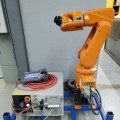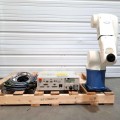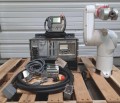 Loading... Please wait...
Loading... Please wait...- Home
- Industrial Robotic Arms
- ABB 6400R, ABB Robot, ABB IRC5, FAnuc Robot Kuka Robot
ABB 6400R, ABB Robot, ABB IRC5, FAnuc Robot Kuka Robot
Product Description
IRB6400R ABB Multi-Function Processor Module
In a cylindrical housing a hollow cylinder, the oscillating piston, oscillates eccentrically. In this manner it transports defined volumes. The method of operation is shown in Fig. 2-5.
The stationary outer cylinder (4) is also the housing, in which a dividing wall (1) and a guide ring (3) are mounted. The dividing wall on the bottom of the housing provides the boundary between the inlet (E) and outlet (A) openings. The bearing for the oscillating piston (5) is mounted in the sleeve (2) and is guided along the dividing wall. Openings for filling and draining are located in its base. In positions (a) and (b) the oscillating piston volume V2 is filled. The liquid forces the oscillating piston away so that the housing volume V1 can be filled. At the same time the force from the piston causes the portion of the liquid volume V1 in the right side to be discharged. When position (d) is reached, the volume V1 has been completely discharged once and refilled, the volume V2 begins its discharge phase. One rotation of the oscillating piston encompasses both volumes, V1 and V2.
The movement of the piston bearing (2) is transmitted to an indicator using a magnet and follower arrangement. A magnetic coupling is not utilized in the RONDO DIRECT Oscillating Piston Totalizer. The rotary motion of the piston is transmitted directly from the piston to the totalizer.
Since the oscillating piston wears rapidly, proper material selection is very important. Various materials are available such as gray cast iron, bronze, hard rubber, carbon and plastics. For high temperature operation an intermediate spacer is used to provide additional separation from the totalizer. Oscillating piston totalizers are especially used for water and oil measurement.















